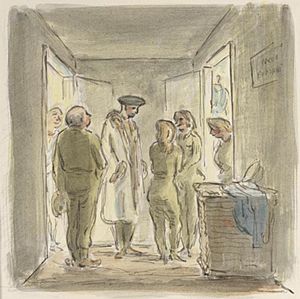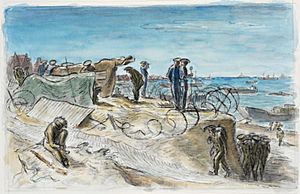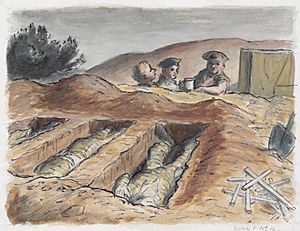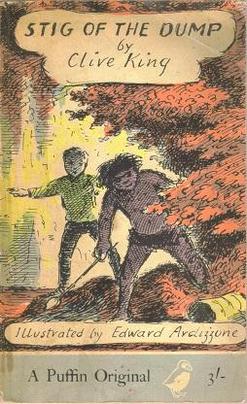Edward Ardizzone facts for kids
Quick facts for kids
Edward Ardizzone
|
|
|---|---|
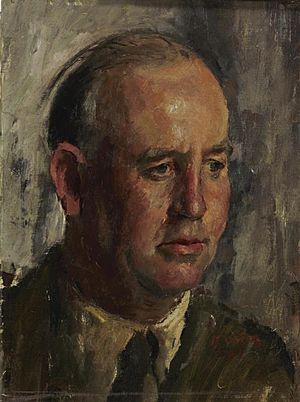
Ardizzone in uniform by Henry Carr, (1944) (Art.IWM ART LD 4056)
|
|
| Born | Edward Jeffrey Irving Ardizzone 16 October 1900 Haiphong, Tonkin |
| Died | 8 November 1979 (aged 79) Rodmersham Green, Kent, England |
| Pen name | Diz |
| Occupation | Artist, illustrator, writer |
| Nationality | British |
| Genre | Children's books |
| Notable works | Tim All Alone (1956) |
| Relatives | Christianna Brand (cousin) |
Edward Jeffrey Irving Ardizzone, known as "DIZ" to some, was a famous British artist, illustrator, and writer. He was especially loved for the many books he wrote and illustrated for children. His book Tim All Alone (published in 1956) was so good that it won the very first Kate Greenaway Medal. This award is given to the best children's book illustration by a British artist. In 2005, for the Medal's 50th birthday, Tim All Alone was even chosen as one of the top ten winning books of all time!
Contents
Edward Ardizzone: Artist and Storyteller
His Early Life
Edward Ardizzone was born on October 16, 1900, in Haiphong, a port city in what is now Vietnam. His father, Auguste, was French with Italian roots, and his mother, Margaret, was English.
When Edward was five years old, his mother brought him and his older siblings back to England. They grew up in Suffolk, mostly looked after by their grandmother. Edward went to Ipswich School and then Clayesmore School. At Clayesmore, his art teacher really encouraged his talent for drawing.
Becoming an Artist
After leaving school in 1918, Edward tried to join the British Army but couldn't. He worked as an office clerk for several years, but he spent all his free time painting. He also took evening art classes in London.
In 1926, with some help from his father, Edward decided to become a full-time artist. His first big job was illustrating a book called In a Glass Darkly in 1929. He also drew pictures for famous magazines like Punch and The Radio Times.
In 1936, he started his most famous series of books, the "Tim" books. These stories were about a young boy named Tim and his exciting adventures at sea. Edward wrote and illustrated all of them himself. The first one was Little Tim and the Brave Sea Captain.
A War Artist's Journey
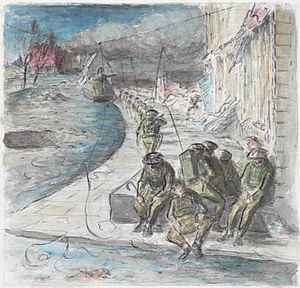
During the Second World War, Edward Ardizzone became an official war artist. This meant he traveled with soldiers to draw what was happening. He drew the British troops as they retreated through France and Belgium in 1940. He also sketched people sheltering in the London Underground during the Blitz bombings.
He traveled to many places, including Northern Ireland, Tunisia, Sicily, and Italy. He saw battles up close and drew the aftermath. He even went to Germany in the final months of the war. By the time the war ended in 1945, Edward had made nearly 400 sketches and watercolors. Most of these, along with his wartime diaries, are now kept in the Imperial War Museum. He also wrote books about his experiences, like Baggage to the Enemy and Diary of a War Artist.
Famous Children's Books
After the war, Edward Ardizzone continued his work as a freelance artist. He drew for magazines, film studios, and even for Guinness adverts. He also painted a portrait of Winston Churchill.
But he is best known for his children's books. The "Tim" series continued with popular titles like Tim All Alone, which won the Greenaway Medal. The series ended in 1972 with Tim's Last Voyage.
Edward also illustrated books by many other authors. He worked on books by Anthony Trollope and H. E. Bates. He drew pictures for Cecil Day-Lewis's children's novel, The Otterbury Incident. One of his favorite partnerships was with Eleanor Farjeon, especially for her collection The Little Bookroom. He also illustrated books by American author Eleanor Estes and a version of J. M. Barrie's Peter Pan.
He had a special way of drawing the title and author's name on book covers in his own handwriting. This gave his books a very unique look. He even illustrated the Nurse Matilda series, which was written by his cousin Christianna Brand. They both grew up hearing the same stories from their grandmother!
In the 1970s, he illustrated new editions of Graham Greene's "Little" books, like The Little Train. His drawings for The Land of Green Ginger by Noel Langley are also considered classics. In 1970, he wrote his own autobiography, The Young Ardizzone, filled with his drawings.
Edward also taught graphic design at art schools. He married Catherine Josephine Berkley in 1929, and they had two sons and a daughter. He passed away in 1979.
Awards and Recognition
Edward Ardizzone received many awards and honors for his amazing work:
- 1956: Won the Kate Greenaway Medal for Tim All Alone.
- 1962: Became an Associate member of the Royal Academy of Arts.
- 1970: Became a full member of the Royal Academy.
- 1971: Was given the title of Commander of the Order of the British Empire (CBE).
- 2007: A blue plaque was put on his former home in London to remember him.
Selected Works
Books written and illustrated by Ardizzone
- Little Tim and the Brave Sea Captain (1936)
- Lucy Brown and Mr Grimes (1937)
- Tim and Lucy Go to Sea (1938)
- Baggage to the Enemy (1941)
- Nicholas and the Fast-Moving Diesel (1947)
- Paul, the Hero of the Fire (1948)
- Tim to the Rescue (1949)
- Tim and Charlotte (1951)
- Tim in Danger (1953)
- Tim All Alone (1956) - Kate Greenaway Medal winner
- John the Clockmaker (1960)
- Tim's Friend Towser (1962)
- Peter the Wanderer (1963)
- Diana and her Rhinoceros (1964)
- Tim and Ginger (1965)
- Sarah and Simon and No Red Paint (1966)
- The Little Girl and the Tiny Doll (with Aingelda Ardizzone) (1966)
- Tim to the Lighthouse (1968)
- The Young Ardizzone - An Autobiographical Fragment (1970)
- The Wrong Side of the Bed (1970)
- Johnny's Bad Day (1970)
- Tim's Last Voyage (1972)
- The Old Ballard of the Babes in the Wood (1972)
- Diary of a War Artist (1974)
- Ship's Cook Ginger (1977)
- Indian Diary (1984)
Books by others, illustrated by Ardizzone
- In a Glass Darkly, (1929), by Sheridan Le Fanu
- My Uncle Silas, (1939), by H E Bates
- Great Expectations, (1939), by Charles Dickens
- Mimff, (1939), by H. J. Kaeser
- The Pilgrim's Progress, (1947), by John Bunyan
- The Otterbury Incident, (1948), by Cecil Day-Lewis
- The Little Bookroom, (1955), by Eleanor Farjeon
- Minnow on the Say, (1955), by Philippa Pearce
- Pinky Pye, (1958), by Eleanor Estes
- Titus in Trouble, (1959), by James Reeves
- The Adventures of Don Quixote, (1959), retold by James Reeves
- The Witch Family, (1960), by Eleanor Estes
- Peter Pan, (1962), retold by Eleanor Graham
- Stig of the Dump, (1963), by Clive King
- Nurse Matilda, (1964), by Christianna Brand
- The Alley, (1964), by Eleanor Estes
- The Land of Green Ginger, (1966), by Noel Langley
- Daddy Long Legs, (1966), by Jean Webster
- Robinson Crusoe, (1967), by Daniel Defoe
- Miranda the Great, (1967), by Eleanor Estes
- The Tunnel of Hugsy Goode, (1972), by Eleanor Estes
- The Little Fire Engine, (1973), by Graham Greene
- The Little Horse Bus, (1974), by Graham Greene
- A Child's Christmas in Wales, (1978), by Dylan Thomas
- Brian Alderson, 'Edward Ardizzone: a preliminary hand-list of his illustrated books, 1929–1970', in The Private Library; 2nd series, 5:1 (1972 Spring), pp. 2–64
- Brian Alderson, Edward Ardizzone: A Bibliographic Commentary (2003. Private Libraries Association) )
- Gabriel White, Edward Ardizzone Artist and Illustrator (1979)
- Malcolm Yorke, To War with Paper and Brush: Captain Edward Ardizzone, official War Artist (2007. Fleece Press, Upper Denby Huddersfield)
- Edward Ardizzone, 'Brian Robb', in Signature; new series, 11 (1950), pp. 37–45
- Edward Ardizzone, 'On the illustrating of books', in The PLA Quarterly; 1st series, 1/3 (1957 July), pp. 25–30
- Edward Ardizzone, 'The Born Illustrator', in Motif; 1 (1958 November), pp. 37–44 (reprinted in Folio (1962 January–March), pp. 1–16)
- Richard Knott, 'The Sketchbook War', The History Press, 2013.
- Lua error in Module:WikidataIdentifiers at line 24: attempt to index field 'wikibase' (a nil value). artworks by or after Edward Ardizzone at the Art UK site


